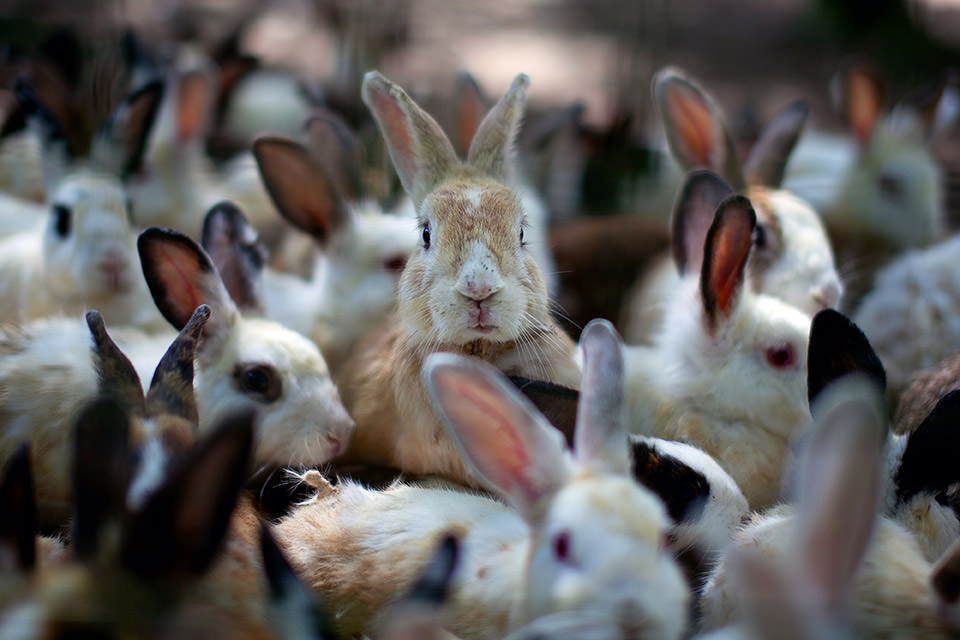Not only are they cute and cuddly, but they also do horribly objectionable things with their feces.

Most North Americans, on the other hand, are a little uneasy about eating bunnies for dinner, though the local food movement has triggered renewed interest in some of the more obscure meats, rabbit included. Foodies can spout off an impressive array of factoids on rare chicken breeds, and the finer points of goat husbandry, but rabbits? That’s new territory. So here’s a quick bit of bunny intel to bust out at your next dinner party.
Rabbits are the second-most farmed variety of livestock in Europe. Residents of Malta, a tiny Mediterranean island, are the most rabbit-ravenous population on Earth, wolfing down nearly 20 pounds per capita annually. By comparison, Americans eat an average of .02 pounds each year; Canadians, .05 pounds. The French, famous for their rabbit stew, eat 6.6 pounds per capita, though they are easily outdone by the nearly 10 pounds of rabbit consumed annually by the average Italian. Rabbit fetus-eating has waned in recent centuries, however.
Rabbits do the unspeakable with their feces. If you had a pet bunny growing up, you may have heard it munching on something in its cage in the dead of night. This was likely not a midnight snack of alfalfa pellets, but a secretive rabbit behavior rarely witnessed: the eating of cecotropes, a special type of feces consumed the moment it comes out in order to digest further nutrients from the poop the second time around. Unlike the “final” rabbit droppings, which are firm and brown, cecotropes are soft, green, and mucus-covered (maybe don’t bring that one up at the dinner table?).
Rabbits really do breed like rabbits. Females are sexually mature in as little as four months after birth, and can be bred again immediately after giving birth. Gestation lasts 30 days, so in theory, a mature rabbit can produce a dozen litters – of up to 14 babies each – per year (rabbit farmers often aim for 8 litters, though 3 to 4 is considered a more humane reproductive pace). If all of those offspring were bred to the max, a single female rabbit would produce upwards of 800 children, grandchildren and great-grandchildren, etc. in one year.
Rabbits were a symbol of fertility in many ancient cultures. For obvious reasons. Though in some myths rabbits are seen as tricksters.
Rabbits played an important role in the history of pregnancy testing. In the 1920s, scientists discovered that by injecting a rabbit with a woman’s urine they could determine whether or not she was pregnant. If she was, the rabbit’s ovaries would become enlarged as a result of being exposed to the hormone hCG. The Rabbit Test, as it was called, gave rise to the expression “the rabbit died!” as a euphemism for “I’m pregnant!” because the rabbit had to be killed to examine the ovaries.
Not just any rabbit’s foot is lucky. According to folklorist Bill Ellis, the full legend is that it must be “the left hind foot of a rabbit killed in a country churchyard at midnight, during the dark of the moon, on Friday the 13th… by a cross-eyed, left handed, red-headed, bow-legged Negro riding a white horse.” Maybe the luck comes from actually obtaining such a rabbit foot.
Rabbits have a special happy dance. It’s called the “Binky.” Doing the Binky means jumping into the air and turning your head back and forth while twisting your body in the opposite direction. It’s considered a sign of play and joy in the world of rabbits. If you’re curious, zillions of Binky videos await you on YouTube.